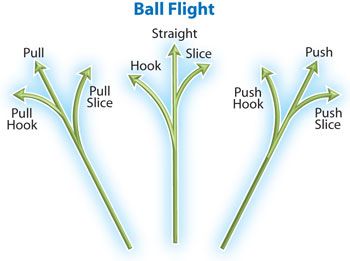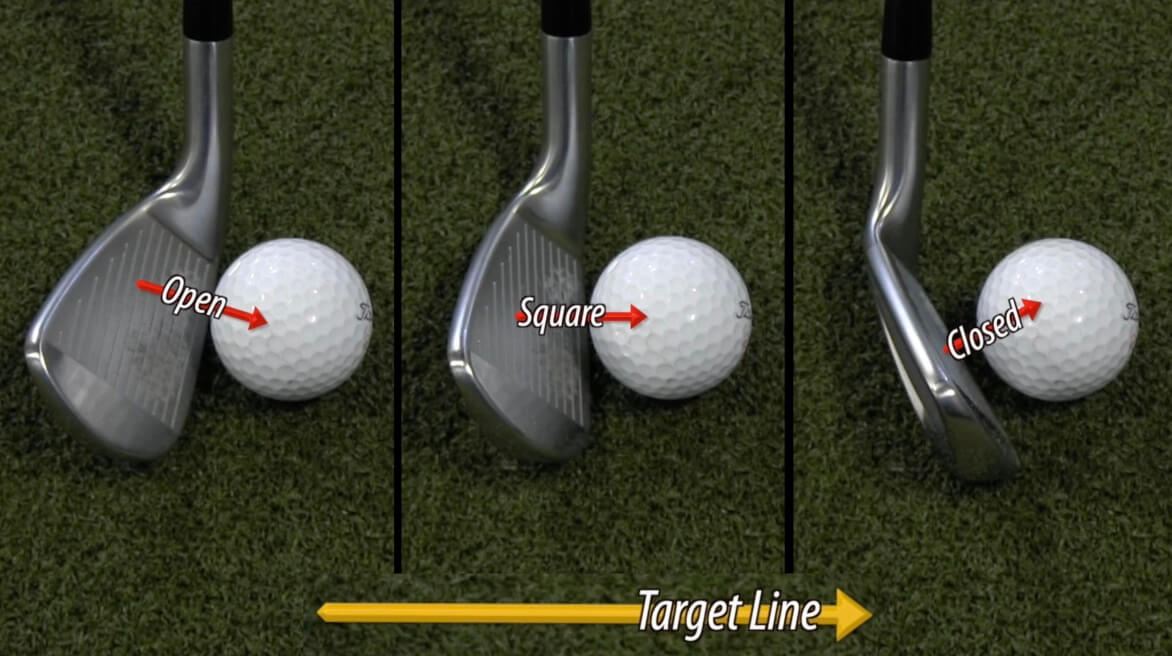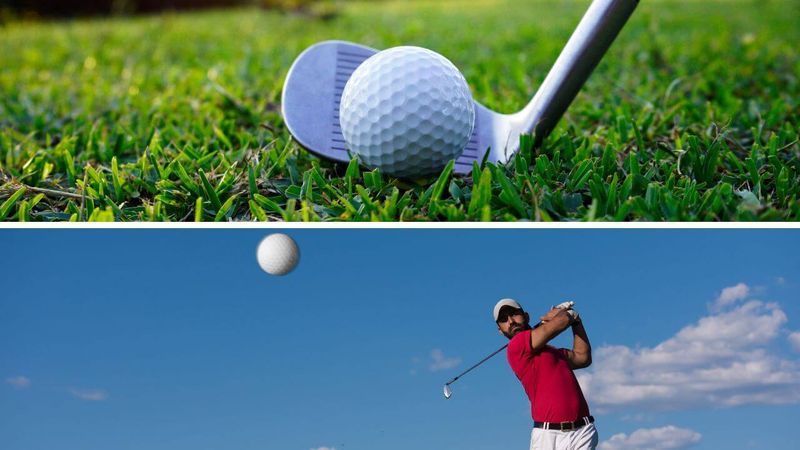Content Summary
Why Is It So Hard To Hit a Golf Ball Straight?
We all want to hit the golf ball straight. But keep in mind, knowing how to curve the ball left and right can come in very handy on holes that dogleg left or right. Check out my article about draws and fades here.
Yes, hitting a golf ball straight is difficult because of the physics involved in the golf swing. At impact the clubface must be square to hit the ball straight on target line which requires proper setup, alignment, and swing mechanics.
The slightest deviation in the clubface angle can cause the ball to spin off course and result in a slice or hook. Additionally, the golf ball itself can be affected by wind, terrain, and other environmental factors, which can make it even more challenging to hit straight shots consistently.
How to consistently hit a golf ball straight requires practice, patience, and persistence, and is a fundamental aspect of improving one's golf game.
Understanding the Basics of the Golf Swing
The golf swing is the fundamental motion of a golfer to hit the ball. It involves a series of movements that requires coordination of various body parts.
The swing encompasses the setup, backswing, downswing, and follow-through. Understanding the basics of the golf swing, including proper stance, grip, and posture, is crucial to improving your game.
Posture With 30-Degree Forward-Tilting Spine
Proper posture is essential to hitting good shots. A 30-degree forward tilt of the spine helps to create the proper angle of attack and promotes a consistent strike. It also helps to avoid strain on the back and improves balance during the swing.
In addition to the benefits mentioned, maintaining proper posture during the swing can also improve your overall body mechanics, leading to greater power and accuracy. When your spine is in a 30-degree forward tilt, your shoulders are more level, allowing for a smoother turn and more effective transfer of energy from your body to the clubhead.
Furthermore, good posture can prevent injuries, particularly to the lower back, which is a common area of discomfort for many golfers here. By keeping your spine in a neutral position, you reduce the risk of excessive strain or compression on the vertebrae and discs in your back.
Proper posture also helps you maintain your balance throughout the swing. When your weight is distributed evenly between your feet, it's easier to maintain your center of gravity and avoid swaying or sliding during the swing. This, in turn, allows you to swing more smoothly and consistently, leading to more predictable ball flights and better overall performance on the course.
Check the Grip
The grip is the only physical contact a golfer has with the club, making it an extremely important aspect of the amateur golfers' swing. Having a proper grip is essential to controlling the clubface and impact position.
A neutral grip is recommended, with the "V's" (formed by the thumb and forefinger of both hands) pointing towards the right shoulder.
A weak grip is one where the hands are positioned too far to the left on the grip (for right-handed golfers), causing the clubface to be open at impact.
This can lead to a variety of shot shapes, including slices and fades. To adopt a neutral or strong grip from a weak grip, the golfer should first check their grip position and make adjustments as needed.
To find a neutral grip, the golfer should start by positioning the clubface square to the target, with the grip pointing towards the center of their body.
The hands should then be placed on the grip, with the left hand (for right-handed golfers) positioned so that the "V" formed by the thumb and forefinger points towards the right shoulder.
The right hand should be placed on the grip, with the "V" formed by the thumb and forefinger pointing towards the right shoulder as well.
Adopting a neutral grip can help improve clubface control and lead to more consistent shots. By placing the hands in the center of the grip, the golfer can more easily square the clubface at impact, reducing the amount of side spin on the ball and promoting a straighter flight.

Pressure in the Hands
The amount of pressure applied to the club handle affects the swing's accuracy and distance. You should grip the club firmly enough to maintain control but not too tight to restrict the swing's natural movement. It's often been said to think of holding a bird in your hands. Just tight enough for them not to be able to fly away.
Check Ball Position in Relation to Your Feet
The ball position can have a significant impact on the trajectory, direction, and distance of the shot. The optimal ball position varies depending on the club being used, the type of shot being played, and the golfer's swing characteristics.
For shorter clubs, such as wedges and short irons, the ball should be positioned in the center of the stance or slightly forward. This helps promote a descending strike on the ball, producing a high trajectory and maximum spin.
For longer clubs, such as drivers, the ball should be positioned slightly forward in the stance, closer to the lead foot. This helps promote a sweeping strike on the ball, producing a lower trajectory and more distance. For long irons and fairway woods the ball should be slightly left of center in a position that allows for a downward strike on the ball.
Incorrect ball position can lead to poor contact with the ball, resulting in a variety of shot shapes and distances. For example, if the ball is positioned too far back in the stance, it can cause the club to strike the ground before making contact with the ball, resulting in a fat or topped shot. Conversely, if the ball is positioned too far forward in the stance, it can cause the club to strike the ball on an upward angle, producing a thin or weak shot.
Checking ball position is an essential aspect of the pre-shot routine and should be done consistently on every shot. You can use alignment aids, such as a club or an alignment stick on the range, to help position the ball correctly. By checking ball position, you will improve your consistency, accuracy, and distance control on the course.
Fixing Your Takeaway
A proper takeaway helps establish the correct swing path and clubface angle, which are critical for producing accurate and consistent shots.
During the takeaway, initiate the swing with a controlled and smooth motion, using your shoulders and arms to move the clubhead straight back along the target line.
The club should be kept on plane, meaning it should follow a straight line back from the ball, in line with your hands and arms. This helps to ensure that the clubhead is on the correct swing path, and the face is square to the target at impact.
Common faults during the takeaway include taking the club too far inside or outside the target line.
Taking the club too far inside, also known as a "too inside" takeaway, can cause your club to become stuck behind your body during the downswing, leading to a variety of swing faults and inconsistent shots.
Conversely, taking the club too far outside, or a "too outside" takeaway, can lead to an over-the-top swing, causing the club to approach the ball from an outside-in angle, resulting in a slice or a pull.
Aiming
Aiming correctly is an essential element of good golf, as it determines the direction of your shots. Proper aim begins with aligning your body and clubface to your target, ensuring that your stance, feet, hips, and shoulders are all pointing in the same direction.
One way to ensure proper aim is to use an intermediate target, such as a divot, blade of grass, or other spot along your intended target line, to help align your body and clubface. By focusing on this intermediate target, you can ensure that you are aiming accurately and consistently.
It's also important to adjust your aim based on the shot shape you are trying to produce. For example, if you want to hit a draw, you may need to aim slightly to the right of your target to allow for the ball's left-to-right curve. Similarly, if you want to hit a fade, you may need to aim slightly left of your target to allow for the ball's right-to-left curve.
Another important consideration when aiming is the slope of the terrain. On uphill or downhill shots, you may need to adjust your aim to compensate for the slope and ensure that your shot lands on target.
Is the Swing the Right Length
A swing that is too long or too short can lead to inconsistent shots and decreased accuracy. The ideal swing length is determined by a golfer's physical attributes and swing style, as well as their swing plane and tempo.
A swing that is too long can cause you to lose control of the club, resulting in shots that are off-target or lack distance.
On the other hand, a swing that is too short can limit your power and distance potential, resulting in shots that fall short of the target.
To determine the ideal swing length, you should experiment with your swing plane and tempo, as well as practice swinging with different club lengths.
Swing plane refers to the path that the clubhead follows during the swing. A flatter swing plane tends to produce a longer swing, while a more upright swing plane results in a shorter swing.
Golfers should experiment with their swing plane to find the ideal path that produces a comfortable and consistent swing length.
Tempo refers to the speed at which the golfer swings the club. A slower tempo typically leads to a shorter swing, while a faster tempo can result in a longer swing. Experiment with your tempo to find the right balance between power and control for you.
Another factor to consider when determining the ideal swing length is the length of the your clubs. You should make sure your clubs are properly fitted to your height and swing style, as using clubs that are too long or too short can negatively impact swing length and accuracy.
Overall, determining if the swing is the right length requires careful consideration of a golfer's physical attributes, swing style, swing plane, and tempo.
By experimenting with these factors and practicing with different club lengths, you can find the ideal swing length that maximizes accuracy and distance potential on the course.
Master Your In-Swing Fundamentals
The in-swing fundamentals include the swing path, clubface angle, and impact position.
The swing path refers to the direction in which the clubhead is traveling during the swing. A proper swing path should be on-plane, meaning that the clubhead should move along a path that is parallel to the target line. A swing path that is too steep or too shallow can lead to inconsistent shots and decreased accuracy.
The clubface angle is another important in-swing fundamental. The clubface should be square to the ball at impact, meaning that the face of the club should be perpendicular to the target line. A clubface that is open or closed at impact can cause the ball to spin and curve off course, leading to shots that are off-target.
The impact position refers to the position of the clubface and ball at the moment of impact. The ideal impact position should be with the ball struck in the center of the clubface, known as the sweet spot. A consistent impact position can help ensure consistent ball flight and distance.
To master these in-swing fundamentals, golfers should focus on maintaining proper mechanics throughout the swing. This includes proper grip, stance, alignment, and body position, as well as maintaining a proper swing plane and tempo.
Also focus on making clean, solid contact with the ball at impact, using drills and practice swings to develop a consistent and repeatable swing.
In addition to practice, you can also use swing analysis tools and seek guidance from a golf instructor or coach to identify and correct any issues with your swing mechanics.
The Left Track (For Right-Handed Golfers)
The left track is the imaginary line that runs parallel to the target line and serves as a visual guide to help golfers maintain a consistent and repeatable swing plane, which is essential for solid ball-striking and accuracy. Right-handed golfers need to ensure that their clubhead stays on the left track during the backswing to avoid coming over the top and hitting a slice.
To stay on the left track during the backswing, right-handed golfers must initiate the takeaway with their left arm and shoulder and keep the clubhead inside the hands. This helps to prevent the club from getting too far outside the swing plane.
In addition to the backswing, the left track is also crucial during the downswing and follow-through. Golfers should aim to bring the club back down on the same path it went up, staying on the left track throughout the entire swing. This will help square the clubface at impact, leading to straighter shots and more distance.
It's worth noting that the left track may vary slightly depending on a golfer's height, swing style, and the type of club they are using. However, as a general rule, it should always run parallel to the target line and be used as a consistent reference point for every swing.
Understanding the Problem
Identifying the root cause of a golf swing problem can be a complex process that requires careful analysis and feedback from a qualified instructor or an experienced player. However, there are several common factors that may contribute to swing issues.
One of the most significant factors that can affect your swing is your setup or address position. Issues such as poor posture, alignment, or ball position can cause swing problems, even for skilled players. Adjusting these factors to optimize your setup can help eliminate many swing issues and improve your ball-striking consistency.
Another common issue that affects swing mechanics is improper sequencing, which occurs when a golfer doesn't move their body in the correct order during the swing. For example, initiating the downswing with the hands instead of the lower body can lead to a variety of swing issues, such as casting or flipping the clubhead, resulting in poor contact and distance.
Golfers may also face swing issues due to technical flaws, such as an incorrect grip or swing path. These issues can be addressed by making adjustments to your technique or using drills to reinforce proper swing mechanics.
Balance and Tempo
Balance and tempo are essential to hitting good shots consistently. During the swing, you need to maintain balance and rhythm to deliver the clubhead to the ball accurately.
The downswing is typically two to three times faster than the backswing, making tempo management critical.
Point Club at Target at the Top of the Swing
Pointing the club at the target at the top of the swing is a sign of a proper swing plane and clubface alignment. It indicates that the golfer has maintained the correct swing path and clubface position
Follow Through Down the Line
Follow Through Down the Line refers to the your motion and position after you have made contact with the ball.
It is a fundamental component of the golf swing that helps improve ball flight, distance, and accuracy. The follow-through motion should be fluid, controlled, and should continue along the target line, which is the path the ball should take.
By following through down the line, you will maintain balance and allow the club to complete its natural path.
Set the Club Down Straight (Square)
A club face that is closed or open at address will cause the ball to veer off to the left or right, respectively. Setting the club down straight ensures that the ball will be hit straight or with a slight draw or fade.

Square Clubface Impact Position
The square clubface impact position refers to the position of the clubface at the moment of impact with the intended line of the ball. The clubface should be square to the target line to produce a straight shot.
If the clubface is open or closed, your golf shots will be slices or hooks, respectively. Achieving a square clubface impact position requires proper setup, alignment, and swing mechanics.
Equipment Upgrades and Enhancements
Golf equipment upgrades and enhancements refer to the use of technology to improve a golfer's game.
This can include new clubs, golf balls, shoes, gloves, and other accessories that are designed to improve most golfers' performance. Upgrades and enhancements can improve a golfer's accuracy, distance, and consistency on the golf course.
Move Arms in One Piece on Takeaway
The arms should move together as a unit, with the shoulders turning to create the power in the swing. This technique helps maintain the club on plane and promotes a consistent swing path.
Weight Transfer and Pressure Shift From Trail To Lead Foot
Weight transfer and pressure shift from the trail to lead foot refer to the movement of the body during the swing.
The weight should shift from the trail foot to the lead foot during the downswing to produce power and generate golf club head speed. This movement also promotes a consistent swing path and helps produce a straight shot.
The transfer of weight and pressure should be smooth and controlled to maintain balance and stability throughout the swing.
Conclusion
Hitting a golf ball straight requires a combination of proper technique, consistent practice, and mental focus. By focusing on a few key fundamentals such as grip, stance, alignment, and posture, you can improve your chances of hitting the ball straight and with greater accuracy.
Additionally, practicing with purpose and developing a pre-shot routine can help you maintain a clear and focused mind during the swing. With patience, persistence, and a commitment to improvement, you can become a more consistent and confident golfer capable of having a straight ball flight.
Remember, golf is a game of incremental progress, and with the right approach, you can continue to improve your skills and enjoy the game for years to come.
Thank you for visiting, and we hope to see you back soon!








